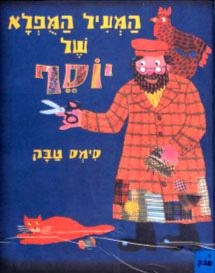Волшебное пальто Иосифа
Симс Табак
Дорогие родители!
В этой книжке происходят чудесные события: старенькое пальто Иосифа меняет свою форму: от него остается одна пуговица, а в конце, когда от него уже ничего не остается, недостаток превращается в преимущество: пальто и вся его история превращаются в …прекрасный рассказ!
Тот факт, что из всех вещей остается лишь рассказ подчеркивает его важность. Если бы не рассказ, не осталась бы память ни о пальто, ни о Иосифе, ни об ушедшем времени, ни о еврейском местечке.
Именно поэтому мы и решили, что именно эта книжка должна открывать «Пижамную библиотечку». «Волшебное пальто Иосифа» - это рассказ о рассказе, и в нем говорится о чудесах, таящихся в словах.
А теперь мысли и идеи для бесед и занятий с детьми после чтения этой книжки.
«И расскажи сыну своему»
Роль рассказа для семьи и для народа
Рассказ - это краеугольный камень еврейской традиции. Он служит средством передачи и сохранения из поколения в поколение истории и обычаев народа. Традиционно еврейский рассказ включает в себя танахические рассказы, богатство мидрашей, притчи мудрецов и огромное количество народных сказаний, создаваемых и передаваемых из поколения в поколение.
___ Расскажите ребенку какую-нибудь семейную историю – которая может вызвать улыбку или в которой есть какая-то изюминка – что-то, чему стоит остаться в семейной памяти, например, что-то из Ваших детских воспоминаний. Включите в эту историю какие-то детали о времени и о месте, в котором она произошла. Поищите вместе в семейном альбоме фотографии места, где родились и выросли бабушки и дедушки ребенка. Рассмотрите вместе все детали на фотографиях, например, « А это булочная, где папа твоей бабушки покупал самые вкусные халы на свете…».
____ Путешествие во времени. «Как выглядит местечко Иосифа?» Предложите ребенку закрыть глаза и отправиться туда в воображаемое путешествие. Теперь покрутите ребенка, остановите его «в том времени» и предложите ему рассказать, что он видит, например, « Есть ли у Иосифа дома телевизор? Какие животные бродят по городку? Проходит ли там автобус? Какую одежду носят люди?» Короче, задайте ему наводящие вопросы, которые помогут ему найти сходства и различия и их причины между «там и тогда» и «здесь и сейчас».
____ У каждого народа свои пословицы и поговорки. Пословица «У старого кафтана только дырки новые» висит в рамке на стене в доме Иосифа и мы ее видим на странице, которая открывается словами «И была у Иосифа старая кофта..». Эта пословица – пример юмора на языке идиш. Сделайте, по примеру этой картины, свою картину, вспомните семейное крылатое выражение из дома родителей или бабушек и дедушек. Расскажите, кто его произносил, когда и по какой причине. Напишите его большими буквами, дайте ребенку разукрасить его и повесьте его на стену.
Кто богат? Тот, кто рад своей доле.
В Мишне, в «Трактате поучений отцов» в главе 7 написано «Кто богат? Тот, кто рад своей доле». Мишна учит, что счастье человека измеряется не богатыми вещами и не деньгами, а способностью довольствоваться и наслаждаться тем, что у него есть. Иосиф, несмотря на свою бедность, богатый человек, потому что он умеет радоваться каждой «новой» вещи, которая получается из старой, поношенной.
__Проследите вместе, с помощью картинок, за настроением Иосифа. Когда он грустен? Когда и почему он весел? Какое у него настроение в конце книги? Как Ваш ребенок объясняет смену его настроений?
___Сделайте два списка: список того, что доставило Вашему ребенку радость в течение сегодняшнего дня, и того, что принесло ему огорчение. Помогите ему найти светлые пятна даже в грустных вещах. Если сейчас вечер , вспомните то хорошее, что случилось со всеми вами за день.
Не уничтожай
Уважение к средствам существования
Заповедь «Не уничтожай», находящаяся в Торе в книге «Дварим» в главе 20, требует не уничтожать плодовое дерево в случае длительной осады города. Из этой заповеди развился более широкий подход к необходимости разумно и экономно использовать все средства нашего существования. Иосиф также не упускает ни одной возможности использовать все, что остается от его пальто, до самого конца.
___Попросите ребенка найти в доме такие вещи, которые изменили свое первоначальное предназначение: например, треснувшая тарелка, которая используется как подставка для цветочного горшка, цветная кружка, которая служит вазочкой для цветов и т.д.
___Поговорите с ребенком о расточительстве. Что значит вести себя расточительно, транжирить? Выбрасываем ли мы такие вещи, которыми еще можно пользоваться? Что можно сделать, чтобы воздержаться от этого?
___Объясните ребенку понятия «из вторых рук», «комиссионный магазин». Проверьте вместе с ним, что можно продать/ передать/ купить в комиссионном магазине, например, подержанные вещи в хорошем состоянии, книги, игры, сувениры и т.п. В чем преимущество покупки «из вторых рук»? Что ребенок готов был бы получить « из вторых рук» и что он готов отдать во «вторые руки»?
Что такое «Пижамная библиотечка»?
«Пижамная библиотечка» организована на основе американской программы “The PJ Library” (PJ – так можно по-английски сокращенно назвать пижаму), разработанной Фондом Гарольда Гринспуна. Эта программа каждый месяц дарит десяткам тысяч семей качественные детские книжки, темы которых связаны с еврейской культурой. Вместе с книжкой семья получает советы для занятий по ней. Фонд Гарольда Гринспуна расширяет свою деятельность, теперь и семьи в Израиле получат этот замечательный подарок. Встреча с книжкой дает возможность для семейной беседы о еврейских ценностях и традициях, позволяет родителям передать следующему поколению свой личный взгляд на эти темы. Мы благодарны многим организациям в Израиле, которые поддержали эту программу и помогли приспособить ее к местным условиям: среди них Министерство Просвещения, Фонд «Тали» /Поддержка изучения иудаизма/, Бейт-Мидраш «Элуль», мидраша «Ораним», «Матан» /институт по изучению Торы для женщин/ и «Матах» /центр образовательных технологий/.





